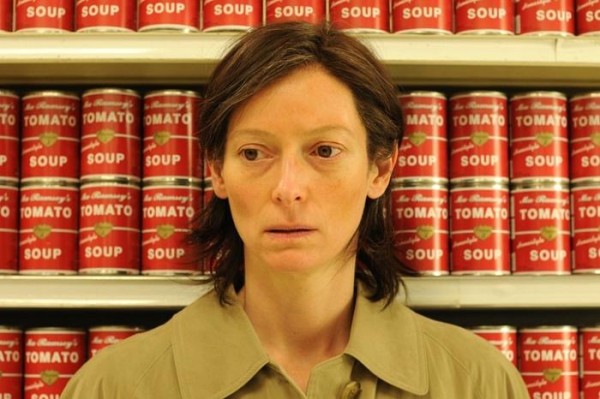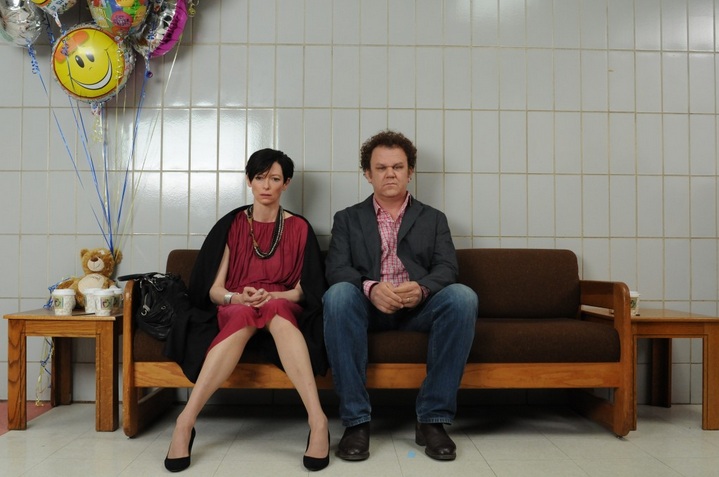|
We Need To Talk About Kevin
Reviewed
by
Damien Straker on
November 17th, 2011
Hopscotch presents
a film directed by
Lynne
Ramsay
Screenplay
by
Lynee Ramsay, Rory Kinnear, based on the novel "We Need To Talk About
Kevin" by Lionel Shriver
Starring:
Tilda
Swinton, John C. Reilly and Ezra Miller
Running
Time:
112 mins
Rating:
MA
Released:
November 17th,
2011
|
8/10
|
|
A woman named Eva (Tilda Swinton) wakes up dislocated
from her
life. The outside of her house is covered in red paint. She is alone
but tries
to reassemble her life by applying for a job in an office. Everyone is
interested in watching her but we are unsure why. Flashing back to an
earlier
time period and we see Eva living with her husband Franklin (John C.
Reilly).
They raise a child named Kevin but she struggles to cope with the baby.
Over
the years she forms a rivalry with her son Kevin because they have no
understanding of each other’s space. He grows up to become a problem
child with
little compassion and only a slightly stronger bond with his father.
Their
lives are further complicated by the arrival of their second child Lucy
(Ursula
Parker), who at one point loses one of her eyes. Cutting in between the
two
timelines is a tragic event that Eva keeps remembering and returning to.

This chilling adaptation of Lionel Shriver’s novel
succeeds in projecting
two separate but common periods of isolation. The first is the most
familiar to
us. It is the conflict between an adult and a child’s perspective of
the world.
A normal mother like Eva holds an expectation for her child to be
obedient,
while Kevin deliberately questions why at every opportunity, through
his
rebellious behaviour. It is rare that either character finds a
cooperative
middle ground. The rivalry between Eva and Kevin is fascinating to
watch
because their relationship shifts regularly between attention seeking
and the
need for separation and independence. Meanwhile, the present day scenes
reveal
that in the absence of children, parental instincts still remain and
can develop
into a deep case of paranoia. It forces a parent to always question the
people
and places in their vicinity. This is reflected through Lynne Ramsay’s
formal
sophistication, a quality seen all too rarely in films this year and
one that gives
the story texture and immediacy.

Images in the film, such as the paint thrown over the
house, or
Kevin’s chomping jaw, are tightly framed. The diegetic sounds of
objects in the
film, such as the rumbling of a sander, are amplified to deafening
levels. The
sound and visuals combine to characterise a deeply claustrophobic
world, where
a parent’s caution of people and spaces separates them from normality.
While
the theme of isolation is carried between both timelines, the
non-linear
narrative frames the story like a mystery. The film is cleverly told
because it
understands how to build tension through its structure. Events in the
present
are selective but then revealed slowly through flashbacks. At one point
Lucy is
shown with an eye patch and then the film moves back in time, building
up to
what happened to her. Similarly, a woman slaps Eva in the face and it
is over
the course of the entire film that we learn why, with mesmerising
results.
These time shifts are deliberately disorientating, revealing Eva’s
disconnection
from the present day. We’re constantly trying to determine how we
reached this
emotional crisis point. The shifts also threaten to derail our
understanding of
the story but the film smartly settles into a more cohesive rhythm.
Whether you
know the eventual outcomes of the narrative from the novel or not, the
events are
told with a foreboding sense of dread.
The centrepiece of the film and why the rivalry is so
accomplished
is due to the dominance of Swinton’s troubled performance. She inspires
one of
the most hauntingly effectively roles this year. Her physical
attributes are an
asset to her work. She already has a thin, hollow face and through the
grim
close-up shots she is able to express her inner-most torment. The
intensity in
her body language too, along with the icy delivery of her lines,
reveals a
frustrated woman, deeply bitter at having her life disrupted by her
child.
Featuring in nearly every scene, a Best Actress nomination early next
year is
highly likely. Ezra Miller as the older Kevin is almost effortless in
creating
an equally cold character and one that we find compassionless and easy
to hate.
Kevin is a highly ambiguous character though and he represents a void
that the
screenplay can never fulfil. The questions surrounding his psychology
are
deliberately unanswered but it also begs for more clues to be left
behind. At
its most simplistic, the film suggests that he holds a desire for
attention.
Following one of the film’s major climaxes, Kevin postures in front of
people
as though he is a celebrity being cheered upon. Yet this is at odds
with an earlier
scene where he wrecks Eva’s computer. She asks him why he does it and
he
replies: “There is no point. That’s the point”. With more hints his
psychology
might have been more conclusive and satisfying. Warmer support is
provided by
John C. Reilly. Predictably, he has a few clever comic moments but also
a much
tighter relationship with Kevin. Their bond makes the very moving
climax all
the more challenging to understand. It suggests that sometimes even the
closest
parents will have trouble understanding why.
|